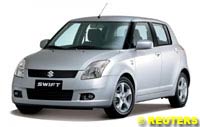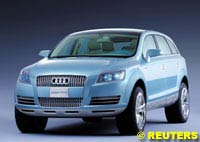

Automotive News and Reviews for the Petrolhead
In this week's issue:
- Car Briefs
- Carmakers Cling to Europe Despite Cost Pressure
- Korean Makers in Fast Lane
At the launch Suzuki described itself as, "not only a world leader in compact cars but also the world's dominant force in motorcycles" - something that might raise a few eyebrows over at Honda. Suzuki insists that the Swift has been designed largely in and for Europe. The company is aware that previous small Suzukis have had no European orientation at all. It also knows how successful the Euro-focused Yaris has been for Toyota.
The Swift is promised to be "a whole lot more enjoyable to drive than anything else in the compact-car category". Engines options will be 1.3 and 1.5-litre petrol or 1.3 diesel, while gearboxes will be five-speed manual, five-speed clutchless manual or traditional four-speed automatic. The instruments have been influenced by motorcycle design and the chassis is said to be more sophisticated than the Japanese small car norm. Prices will be announced closer to launch.
The Vanquish S has 520 bhp (up from 460 bhp), providing a top speed of "over 200 mph". Aston CEO, Dr. Ulrich Bez commented, "The latest Vanquish S is not only the fastest Aston Martin ever, but it is the best-handling too. It is the ultimate high-performance Aston Martin." As well as more performance, the new model gets revised suspension, braking and steering. Prices are yet to be announced.
The logic behind the name is that the car slots in between the A6 and A8, while the letter Q stands for Quattro - it is a four wheel drive, after all. The Q7 will be a seven-seater to compete with the Volvo XC90 and next-generation BMW X5, which will be half a size larger than the current model. Audi rather missed the boat with the tame A6 Allroad and is determined to catch up in the off-road segment. The fact that Audi has created a new designation, Q, suggests that there could be other such models. A Q5 to compete with the BMW X3 would be the obvious follow-up.
When fitted to the Hatch, the new turbo petrol engine has a top speed of 137mph, a 0-62mph time of 8.3 secs and combined fuel economy of 36.7 mpg. In the case of the Megane Hatch, Sport Hatch and Coupe-Cabriolet, the introduction of the turbocharger has actually improved fuel consumption and emissions. The Megane Hatch for example returns 36.7mpg on a combined cycle - an increase of 1.4 mpg over its normally aspirated brother, while emissions fall by 7g/km to 184.
The new models are fitted with a six-speed gearbox, Thatcham category 1 alarm and immobiliser and remote central locking. In addition, Electronic Stability Programme (ESP) will be fitted free for a limited period. Prices start at £15,090 for the 3-door Dynamique, rising to £20,820 for the Coupe Cabrio Privilege.
Carmakers will continue to build models in western Europe despite intense cost pressures but the industry there will have to become meaner and leaner to compete with cheaper countries, company officials say.
Companies are already trying to cut costs at western European plants through wage restraints and closing some capacity to reap the most advantage from being close to customers and avoiding hits from currency fluctuations.
At the Paris Motor Show this week, even the French manufacturers, who are faring better than most of their rivals and who would face political pressure if they tried to shut plants at home, said they would likely choose cheaper countries outside western Europe where demand is growing faster for any new plants.
DaimlerChrysler's Mercedes arm is actually adding 800 jobs at a plant making its successful A-class cars, while Nissan announced plans at the show to build its next-generation family car at its plant in Britain. But most manufacturers now feel chronic overcapacity in Europe, as Asian carmakers expand in an already crowded market, will force reform and that it could even come down to the survival of the fittest.
Europe's biggest carmaker Volkswagen and U.S. giant GM both hope to whittle down costs by freezing wages. Ford luxury unit Jaguar announced last week it would halt car production at a UK plant and cut over 1,100 jobs. Volkswagen said it wanted to stay close to its customers and was reforming to make this possible.
Saab Chief Peter Augustsson said his company was also cutting back on jobs.
"We are actually reducing. We took out some substantial amount of people a couple of years ago in our Swedish operation and it will continue," he told CNBC. "You could say that we are reducing our costs by about 15-20 percent in manufacturing. That means there will be fewer people doing more and that's part of this industry's development."
Too Costly to Scrap?
Fritz Henderson, head of loss-making GM Europe, said his company could not afford to scrap its investment in the region and start all over again further afield. But, as the company looks to cut costs by building mid-sized cars in Europe at just one plant from 2008, Henderson said the place of production was not a deciding factor for most buyers.
"Some people actually care exactly where a car is built, but the research we do tells us (it is) not that many".
GM has denied it is pitting the Opel plant in Ruesselsheim, Germany, against the Saab plant in Trollhattan, Sweden. Swedish wage costs are around 35 percent lower than German ones, GM Europe President Carl-Peter Forster said, even though transport costs are higher.
But he rejects media accusations GM is blackmailing German workers into accepting lower wages. Unions say the carmakers should take the pain from sluggish global markets and soaring raw material prices themselves and not push them onto workers at a time when jobs are scarce.
"Against the backdrop of chronic high unemployment, it is very obvious that the carmakers are using the situation to cut wage agreements," said Reinhard Dombre, a wage agreement expert at the German trade union group DGB in Berlin.
Italy's Fiat Auto, which has cut thousands of jobs over the past 2 years to stay afloat, is now trying to save cash by squeezing workers into a smaller space at its sprawling Mirafiori plant. Nevertheless, any wake for the car industry in western Europe is likely to be premature.
"It is a little bit hard to imagine an industry that is entirely an import industry into Europe," said GM Europe's Forster.
French carmaker Renault, which has fared well this year thanks to a hit range of products and a money-spinning alliance with Japan's Nissan, said shutting efficient factories in western Europe was "absurd" and noted the company planned to employ extra workers in France this year.
Its domestic rival PSA Peugeot Citroen, emerging from a product drought and predicting growth ahead, said shifting away from a region it hoped will continue to expand, albeit slowly, did not make sense. And Europe has advantages which could outweigh some of the costs and constraints.
"Europe builds thrilling products, it's innovative and strong in development and has an excellent supplier industry," said VW finance chief Hans Dieter Poetsch. "Certainly there are challenges. But that can't be met with end-of-the-world sentiment, rather one has to act."
Korean car makers are set to continue zooming through the pack in the sluggish European market as they roll out more cars in untapped segments to emerge from their fringe status and challenge dominant local stalwarts.
Hyundai, its affiliate Kia Motors and GM Daewoo are still small players in Western Europe with a combined market share of 3.9 percent in the year to date, but are enjoying double-digit jumps in sales thanks to the popularity of their small, cheap and fuel-efficient cars.
The three companies boosted their sales by 22 percent in the year to date, moving more than 386,000 vehicles, compared with the overall market's 1.8 percent rise. Hyundai and Kia, South Korea's top two auto makers, stressed at the Paris Motor Show this week they would attempt to keep expanding by offering a whole range of vehicles designed specifically for the European market.
"We are moving to be a generalist. We will be in all segments, including eventually in the premium area," said Jean-Charles Lievens, vice president of Kia Motors Europe, which unveiled the all-new sporty Sportage compact sport-utility vehicle (SUV) at the Paris show on Thursday.
"We weren't big in passenger vehicles until recently, but now with the Picanto and Sorento cars, we are really expanding in Europe," he told Reuters.
A soaring euro has made Europe a mouth-watering target for Korean auto makers in search of new sales to offset weak local consumption and a slackening US market. Hyundai has similar ambitions as its sister company in Europe as it drives towards its broader goal of becoming one of the top five car sellers globally by 2010 as a group. It now ranks seventh in the world.
"Shifting to higher-segment products is a key strategy for us in Europe," Werner Frey, vice president of Hyundai Motor Europe, said at an industry conference in Paris this week, adding that higher-margin models like the Tucson SUV would also lift profitability.
"Our image of offering low-priced cars has changed," he said, adding that Hyundai would offer products ranging in price between 9,000 and 35,000 euros. Hyundai wants to raise European profit margins to 3 percent from around 1.5 to 2 percent now, he told Reuters.
South Korea's biggest car maker is targeting sales of 350,000 units in Europe this year, up 30 percent from 2003, and a jump to 600,000 by 2010. Frey said Hyundai was also starting to look at the prospect of offering luxury cars in Europe, though he conceded it would be a difficult market.
With market share of 2.0 percent and growing, Hyundai is Asia's third-biggest brand in Europe behind Toyota and Nissan.
Meanwhile, Lievens said he expects a jump of 40 percent this year for Kia's European sales while aiming for a further 50 percent jump in 2005 to 300,000 units for a market share of 2 percent.
Risks Remain
Analysts agreed that Korean brands will continue to see sharp rises in European exports.
"The overall sales outlook is good. We can expect Korean car makers to sustain double-digit growth in European sales until 2006, although the pace might be easing off a bit," said Suh Sung-moon, an auto analyst at Dongwon Securities.
He added, however, that while Koreans are enjoying the benefits of a strong euro, which makes their products cheaper in Europe, they faced profit risks due to lack of a natural hedge against currency swings. Hyundai has no local factory in Europe, while Kia's planned 200,000-unit-a-year assembly plant in Slovakia won't come on stream until late 2006.
"Had it not been for a stronger euro, they would have suffered low margins or even losses there. A foreign-exchange risk remains a headache given growing exposure in the region," Suh said. Kia's Lievens conceded that currencies were a risk, but said production in Slovakia would ensure a sufficient buffer by bringing locally produced cars to 40 percent in Europe.
Samuel Rhee, an analyst with Morgan Stanley, said Korean brands could also face more competition as the Japanese brands improve their small cars like the Nissan Micra and Mitsubishi's Colt. The Japanese, however, seemed to see things differently.
"Korean brands are certainly becoming a force to be reckoned with in Europe," said Osamu Masuko, MMC's managing director in charge of overseas operations. "Competition will likely heat up as they add value to their products."
![]() Car Briefs
Car Briefs
 Suzuki has unveiled the new Swift at the Paris Motor Show prior to its launch in early 2005.
Suzuki has unveiled the new Swift at the Paris Motor Show prior to its launch in early 2005.
 When the new DB9 was announced, commentators wondered where that left the Vanquish - 50% more expensive but little faster. Now Aston Martin has responded by creating the Vanquish S.
When the new DB9 was announced, commentators wondered where that left the Vanquish - 50% more expensive but little faster. Now Aston Martin has responded by creating the Vanquish S.
 Audi has confirmed production for the "Pike's Peak" showcar. It will go into production in 2006 with the name Q7.
Audi has confirmed production for the "Pike's Peak" showcar. It will go into production in 2006 with the name Q7.
 Renault has introduced a new 2 litre, 165 bhp turbo engine across the whole Megane and Scenic range.
Renault has introduced a new 2 litre, 165 bhp turbo engine across the whole Megane and Scenic range.
![]() Carmakers Cling to Europe Despite Costs
Carmakers Cling to Europe Despite Costs
![]() Korean Makers in Fast Lane
Korean Makers in Fast Lane
| Contact the Editor |
© 2007 autosport.com . This service is provided under the Atlas F1 terms and conditions.
|
Volume 10, Issue 39
Atlas F1 Exclusive
Interview with Vitantonio Liuzzi
Interview with Paul Stoddart
Bjorn Wirdheim: Going Places
Ann Bradshaw: Point of View
2004 Chinese GP Review
2004 Chinese GP Review
Technical Review: China
The Confidence Trick
Stats Center
Qualifying Differentials
SuperStats
Charts Center
Columns
The F1 Insider
On the Road
Elsewhere in Racing
The Weekly Grapevine
> Homepage |